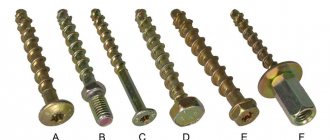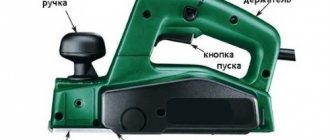The market for building materials for working with electrical communications, machinery and low-voltage equipment offers a wide range of tools. Let's look at what an indicator screwdriver is. Let's get acquainted with the design of various modifications and their functionality. After reading the article, it will be easier to make the best choice for solving certain problems in everyday life or during repairs.
A simple indicator screwdriver with a neon light Source allegroimg.com
Types of devices
The main structural elements of the tools are a narrow flat blade (“minus” screwdriver) and a light or sound indicator. The remaining parts serve as additional components. For example, the housing connects, hides and protects parts. Batteries provide the power necessary for the operation of the indication or electronic display. Let's take a closer look at the device, operating principle and how to use this or that tester screwdriver.
Components of a universal device Source instrumentgid.ru
Neon lamp probe
The design of such an indicator screwdriver is considered the simplest in its group. It is intended to solve only one problem - determining the presence or absence of voltage in the conductor. In this case, operation is possible only if the threshold of 60-70 Volts is exceeded. Rarely, screwdrivers are used for a 12-36 V network.
Structurally, the electrical probe consists of a metal tip and a body. Inside the handle there is a neon light bulb and a microcircuit with a transistor and a resistor. Additionally, a spring and a closing plate can be installed on the end of the handle.
The principle of operation of the device without a contact pad is simple. Here the indication is triggered after the tip touches a serviceable section of the low-voltage circuit. The plate in other probes serves to supply current to the light bulb. Here you just need to touch the sensor with your finger. It is safe for a person to be the contactor of the second contact of the indicator in the chain, since the resistor has a resistance value in the range of 0.5-1 MOhm.
Tester with batteries
This device is equipped with a field-effect or composite transistor (usually bipolar), LED indication, and a contact plate.
Tester with batteries Source amazon.com
The latter is needed to determine the functionality of the screwdriver. A person must touch the tip and the end of the handle, then the light will light up (if the tester is in good condition).
There is also a slot for placing 2-3 coin-type batteries. If the indication does not work during the test, then they need to be replaced. To do this, simply unscrew the end part of the handle.
The functionality of the LED device includes solving the following problems:
- Determination of phase. A similar action is typical for any type of indicator screwdriver. However, with a battery-powered sample, wires in an insulating winding can be examined with the same efficiency.
- Definition of zero. A simple probe does not distinguish an open circuit from a neutral conductor - the neon light does not light in both cases. A tester with batteries can replace a multimeter, as it is able to detect and show the integrity of the cable.
- Calling. This implies an inspection of fuses, heating elements, and incandescent lamps for integrity. It is also possible to detect a break in the winding of a transformer or other electrical device or equipment.
Checking an incandescent lamp Source yandex.net
- Breakdown check. This action applies to diodes, including searching for anodes with cathodes.
- Search for cable. This is especially true when repairing walls with hidden wiring. But a particular device has a limitation in the depth of the desired line. The indicator does not exceed 1.5 cm.
Inexpensive indicator screwdrivers for their cost allow you to solve quite a lot of problems. However, there is one important drawback - small batteries have a low charge. To prevent the batteries from running out longer, experts recommend that the protruding part of the tip be insulated during passive storage of the device. For example, you can take a PVC tube (cambric) of the required diameter and cut a cap of sufficient length from it.
See also: Catalog of companies that specialize in electrical work of any complexity
Non-contact device
The tester, similar to the previous version, runs on batteries. Only here batteries are used with higher power (for example, type 23A at 12 V). Also, a distinctive feature is not a metal tip, but a short plastic tip. The voltage indication is supplemented by an audible signal.
Contactless device Source 5×86.ru
Such electrical receivers are characterized by high sensitivity. There are samples on which adjustment is permissible in order to test the network with different voltages. Thanks to the built-in sensors, work can be performed without direct contact of the tip with the conductor or its insulation.
In addition to searching for wires connected to the network and determining voltage (or lack thereof), a non-contact screwdriver-voltage indicator can find hidden metal elements. This could be a disconnected cable or reinforcement in a reinforced concrete structure. Such an error is an unjustified addition. Therefore, it is better to entrust the search for wiring to other devices.
Universal device
The combined type of indicator screwdriver combines a light and sound indicator, a metal tip, and batteries. This also applies to the functional part. Here you can perform work using the contact method and without touching the conductor or its insulation. You can check the integrity and connection of the cable, determine polarity, look for breaks and short circuits in both direct and alternating current conditions.
Universal screwdriver-indicator Source zubr-vrn.ru
Electronic devices
Due to their wide functionality, such electrical probes are conventionally called a miniature version of a multimeter. But you should not rely on the device’s readings due to its low accuracy. The indication here can be LED (there are 2 or more of them, different colors) or the information is displayed on a liquid crystal display. The verification method is contact and non-contact.
Checking the indicator's functionality
Before using a tester screwdriver, you must definitely check its functionality and integrity. Both the accuracy of the readings and the safety of the person using the device will depend on this.
First of all, you need to pay attention to the integrity of the case - if there are chips, cracks and other damage on the case, then replace the tester. A new one will not cost much, but the consequences of an electric shock can be very serious.
Check the operation of the indicator on the socket, which is under voltage, or by closing the internal circuit with your hands (put one finger to the tip, and the second to the “heel”). If the indicator does not light up, there may be various reasons. The most common problem is dead batteries. Every person can cope with changing them. It is necessary to unscrew the device body, replace the battery with a new one and assemble it in the same order. Do not forget that the battery is installed with correct polarity, otherwise the screwdriver will not work.
If the cause of the failure is not the battery, then repair is advisable only for fun - it is much easier to purchase a new tester. The exception is the situation when you have accumulated an arsenal of broken screwdrivers, from which you can assemble a working product yourself. And always be careful when working with devices and electrical networks. It is better to leisurely recheck the measurement result several times than to receive an electric shock.
Criteria for selecting an electrical probe
Experts recommend equipping your home workshop (toolkit) with a simple contact screwdriver-indicator with an LED. This is enough to detect voltage or determine the integrity of the conductor, to find its location in the thickness of the wall. Samples with broad functionality are distinguished by more thorough instructions for the user, which requires constant practice to memorize.
The main selection criteria look like this:
- Voltage . For a single-phase network, the limit values can be 70-250 or 100-250 V, for a three-phase network - up to 400 V. If you have to work with a low-voltage network, then 12-24-36 V are considered.
Tester for working with networks up to 250 V Source zubr-vrn.ru
- Tip length . The size can be 12 or 18-19 mm. That is, it is either easier to work in hard-to-reach places (oven) or when the research object is located at a distance (wire, contacts).
Before paying, it is important to check the device for serviceability. You also need to find out the type of batteries used; it is better to purchase spare ones in advance. Among other things, you need to find out in advance how to use a particular indicator screwdriver.
Determination of zero and phase
Many novice electricians and people who decide to repair electrical appliances on their own are interested in how to find phase and zero with an indicator screwdriver. To do this, you should adhere to the following operating algorithm:
- first the wiring is de-energized;
- the wires that need to be tested must be stripped of the insulating winding;
- after which you need to turn on the electricity;
- Use the probe to touch the wires one by one, while remembering that the circuit must be closed with a finger on the contact plate;
- the wire that, when touched, lights up the light bulb, is a phase of the electrical circuit.
How to find phase and zero with an indicator screwdriver in a socket? To do this, you need to place the probe one by one in the holes of the socket. When a phase is detected, the light will light up. There will be no glow if the screwdriver shows zero. If, when touching both holes of the socket, the light bulb does not light up, this indicates a break in the zero.
In addition to using an indicator screwdriver, you can determine the phase by the color of the wire:
- the yellow-green wire is ground;
- phase wire color - black;
- zero has a blue wire color.
If the color distribution is not observed, you will need an indicator screwdriver to determine.
Rules for using testers
It is permissible to work only with a working tool. This doesn't just apply to batteries. It is important that there is no damage to the case. For safe use, experts recommend discarding the insulating tape and replacing the screwdriver with a new one.
As for the network, it needs to be de-energized. Even after a power outage, exposed areas of wiring can only be touched with a testing tool. Moisture in any form must be excluded to eliminate the risk of electric shock.
Checking the network with the machines turned off Source brigadir-info.ru
When checking the electrical wiring, do not touch the metal tip. A voltage with parameters that are characteristic of the network under study passes through it. The body of the pen is made of plastic that can protect a person from electric shock. Otherwise, the manufacturer writes in the instructions how to use the indicator screwdriver. Let's take a closer look at these recommendations.
Checking the serviceability of the tool
In addition to identifying external damage, you need to know how to check the indicator screwdriver for functionality. To do this, just insert the tip into each socket of a known working socket. A working device turns on the indication during contact with the phase.
How to operate different devices
A simple device needs to be applied with a tip to one of the conductors. If there is a contact plate, then you need to touch it with your finger. This is where the work ends, there are no other instructions.
How to use an indicator screwdriver with an LED - the rules are similar to the simplest tool for a contact sample. Only the contact plate is touched to check the serviceability of the tool.
Checking the indicator screwdriver for functionality Source eltctricon.ru
Non-contact testers do not provide for closing the internal circuit. Here the indication is triggered at a distance from the network if there is voltage in a specific area. However, the diode can also light up at an open circuit, which is important to consider during testing. But you can work with low-voltage systems.
Universal testers are a little more complicated. There is a contact plate and a light indication that works when the internal circuit is closed. In addition, there may be a built-in toggle switch for setting one or another operating mode. The marking implies the following:
- O. _ Network testing is performed using the principle of a simple screwdriver with a contact pad.
- L. _ The operating principle is identical to a contactless battery-powered device.
- H. _ High sensitivity mode. You can work with a low response threshold, which helps detect hidden wiring.
Device with a toggle switch for setting the operating mode Source yandex.net
HOW TO TERMINATE WIRES WITH AN INDICATOR SCREWDRIVER
An indicator with a battery allows you to check the wires for integrity. To demonstrate this function, you need a cable or wire and access to its ends.
To use an indicator to check a cable or wire core for damage, you need to clamp the upper contact on the indicator and touch the wire core with its working end, and hold the opposite wire with your hand. If the indicator lights up, it means that the conductor core is intact; if NOT, the wire is damaged. In the same way, you can check heating elements or fuses in electrical equipment, remember - if they are working properly, the signal should pass through and the diode in the screwdriver will light up.
Briefly about the main thing
An indicator screwdriver is a device for detecting voltage in the network.
Depending on the modifications of the probes, you can additionally search for wires in walls, determine polarity, and detect open circuits or short circuits.
There are contact and non-contact devices, with neon or diode indication. There are samples with sensitivity settings and a digital display.
The user instructions include a preliminary check of the serviceability of the tool and how to operate a specific model.
Scope of use
An indicator screwdriver, which is popularly called a tester, or a probe screwdriver , has a fairly simple operating principle and design, but at the same time performs one of the most common functions required in electrical installation - checking the functionality of devices or a network.
For example, it is inappropriate to use multifunctional and expensive equipment to solve such a task as checking the operation of an outlet - using an indicator screwdriver, this can be done in a few seconds without the need to disassemble the device. In certain situations, it may be necessary to determine the phase conductor in order to connect electrical equipment without the risk of burning it out. In this case, a tester screwdriver will also be the best assistant.











